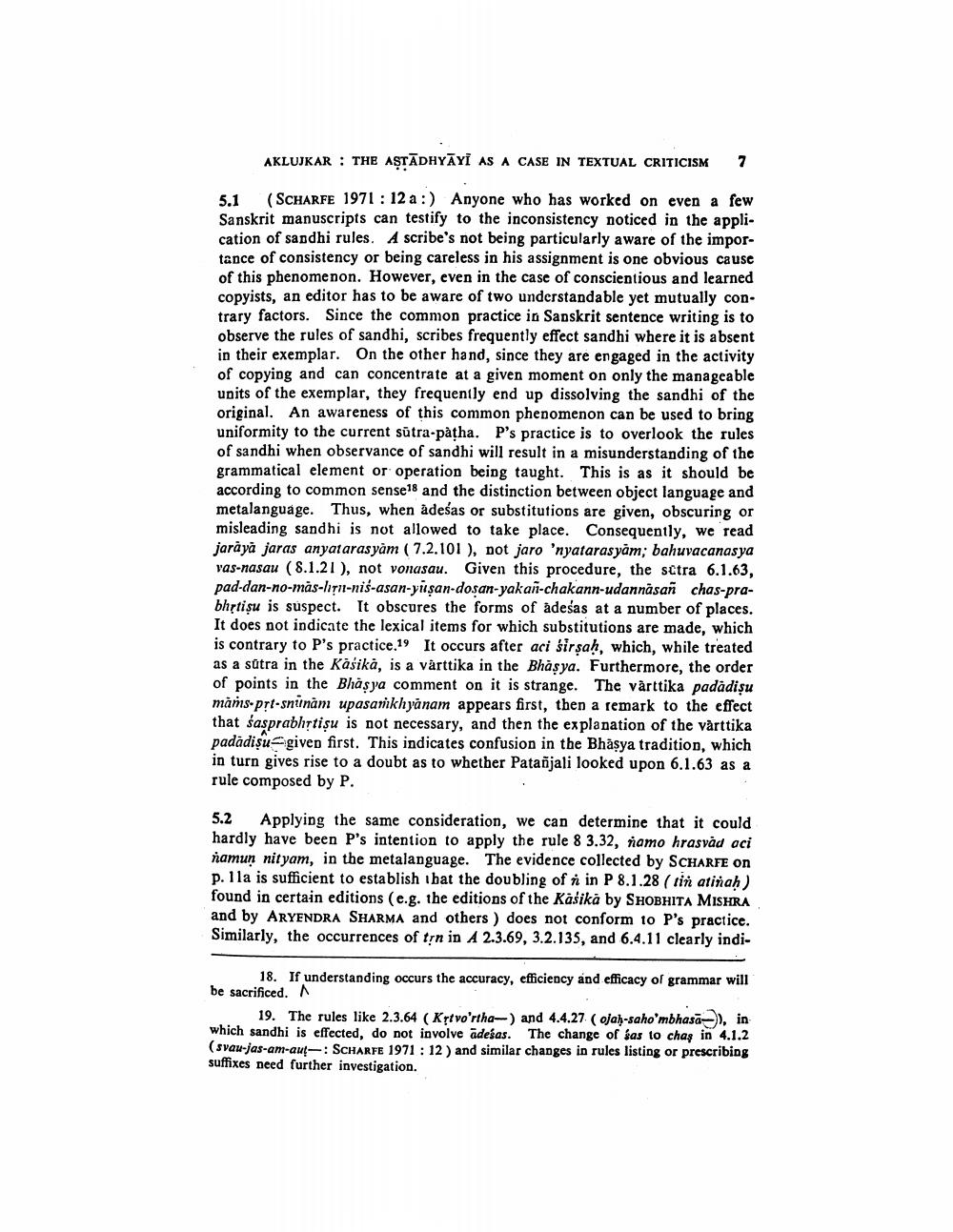________________
AKLUJKAR : THE AŞTĀDHYAYI AS A CASE IN TEXTUAL CRITICISM
7
5.1 (SCHARFE 1971 : 12 a :) Anyone who has worked on even a few Sanskrit manuscripts can testify to the inconsistency noticed in the application of sandhi rules. A scribe's not being particularly aware of the importance of consistency or being careless in his assignment is one obvious cause of this phenomenon. However, even in the case of conscientious and learned copyists, an editor has to be aware of two understandable yet mutually contrary factors. Since the common practice in Sanskrit sentence writing is to observe the rules of sandhi, scribes frequently effect sandhi where it is absent in their exemplar. On the other hand, since they are engaged in the activity of copying and can concentrate at a given moment on only the manageable units of the exemplar, they frequently end up dissolving the sandhi of the original. An awareness of this common phenomenon can be used to bring uniformity to the current sutra-patha. P's practice is to overlook the rules of sandhi when observance of sandhi will result in a misunderstanding of the grammatical element or operation being taught. This is as it should be according to common sense18 and the distinction between object language and metalanguage. Thus, when adeśas or substitutions are given, obscuring or misleading sandhi is not allowed to take place. Consequently, we read jaraya jaras anyatarasyām (7.2.101 ), not jaro 'nyatarasyām; bahuvacanasya vas-nasau (8.1.21), not vonasau. Given this procedure, the setra 6.1.63, pad-dan-no-mas-limi-nis-asan-yilsan-dosan-yakai-chakann-udannäsan chas-prabhrti su is suspect. It obscures the forms of adešas at a number of places. It does not indicate the lexical items for which substitutions are made, which is contrary to P's practice.19 It occurs after aci sirsah, which, while treated as a sutra in the Kašika, is a vårttika in the Bhasya. Furthermore, the order of points in the Bhasya comment on it is strange. The vårttika padădişu mans-prt-snunam upasankhyanam appears first, then a remark to the effect that śasprabhttisu is not necessary, and then the explanation of the varttika padădişu givep first. This indicates confusion in the Bhăşya tradition, which in turn gives rise to a doubt as to whether Patañjali looked upon 6.1.63 as a rule composed by P.
5.2 Applying the same consideration, we can determine that it could hardly have been P's intention to apply the rule 8 3.32, namo hrasvad oci namun nityam, in the metalanguage. The evidence collected by SCHARFE on p. Ila is sufficient to establish that the doubling of i in P 8.1.28 (tin atinah) found in certain editions (e.g. the editions of the Kašika by SHOBHITA MISHRA and by ARYENDRA SHARMA and others ) does not conform to P's practice. Similarly, the occurrences of trn in A 2.3.69, 3.2.135, and 6.4.11 clearly indi
18. If understanding occurs the accuracy, efficiency and efficacy of grammar will be sacrificed.
19. The rules like 2.3.64 ( Kytvo'rtha-) and 4.4.27 (ojah-saho'mbhasa), in which sandhi is effected, do not involve adešas. The change of sas to chap in 4.1.2 (svau-jas-am-aut-: SCHARFE 1971 : 12 ) and similar changes in rules listing or prescribing suffixes need further investigation.




